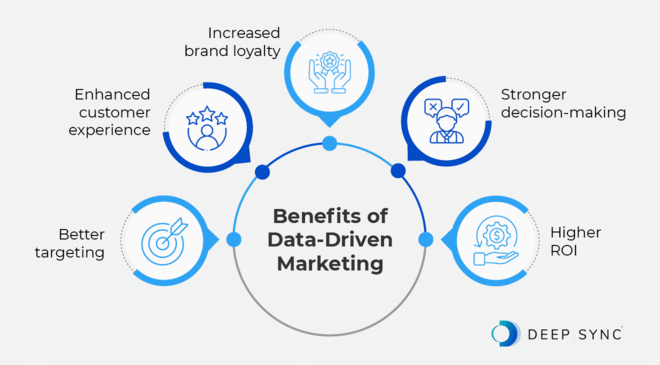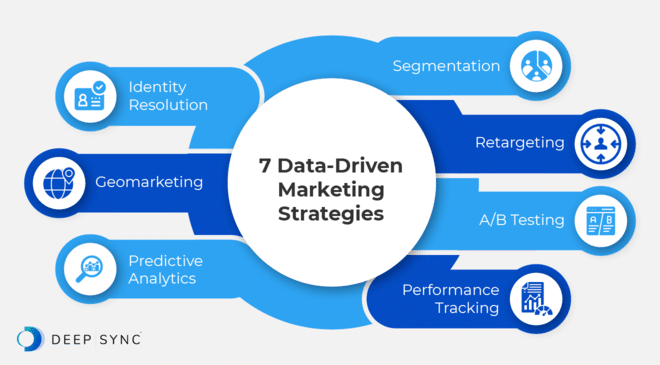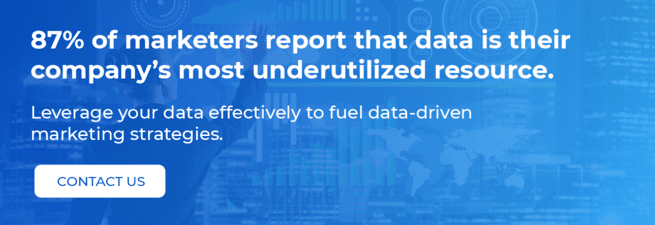As a marketer, you know that data is critical to your success. However, simply having the right data isn’t enough.
With 87% of marketers reporting that data is their company’s most underutilized resource, businesses need to upgrade their data-driven marketing strategies to maximize the data at their disposal, reach their target audiences more effectively, and boost return on investment (ROI).
In this guide, we’ll help you refine your data-driven marketing strategy by covering the following:
- What is data-driven marketing?
- What are the benefits of data-driven marketing?
- 7 Data-Driven Marketing Strategies
- Current Data-Driven Marketing Trends

What is data-driven marketing?
Data-driven marketing is the process of using quantitative and qualitative insights to guide your company’s promotional efforts. Instead of developing a strategy based on what you think will resonate with your audience, data-driven marketing provides a methodical, measurable approach to achieving your marketing goals.
What are the benefits of data-driven marketing?
When you leverage data-driven marketing, your business will receive the following benefits:

- Better targeting. When you base campaigns on data related to customer behavior, demographics, and preferences, you’re more likely to reach your target audience and serve them relevant messaging.
- Enhanced customer experience. Stronger targeting results in messages tailored to customers’ interests and needs, which provides better, more personalized experiences with your business.
- Increased brand loyalty. If customers are more engaged and satisfied with their customer experiences, they’re more likely to continue supporting your company.
- Stronger decision-making. Use data to test different tactics, determine what works well for your audience, and adjust your strategy accordingly.
- Higher ROI. Between improving conversion rates and focusing resources on strategies that actually work, you’ll boost ROI and see better results from your marketing efforts.
7 Data-Driven Marketing Strategies

1. Segmentation
Your business can use data to segment customers based on shared characteristics, behaviors, and interests. This practice enables detailed audience targeting, making it easy to develop campaigns that resonate with customers.
For instance, you may segment your audience according to:
- Demographics. Categorize consumers based on demographic factors such as age, gender, income level, education, marital status, and occupation. Different demographic groups often have distinct preferences and needs. For example, if you run an online clothing store, you can tailor your product recommendations differently for Gen Alpha and Gen Z than for older age groups.
- Behaviors. Behavioral segmentation involves analyzing customer behavior, such as their past purchase history, browsing habits, interactions with your website, and engagement with previous marketing campaigns. Create segments like “frequent shoppers,” “cart abandoners,” or “product page visitors” to send personalized messages or offers that align with each group’s behavior and interests.
- Geographic location. Dividing your audience based on their location, such as state, city, or even specific neighborhoods, can be effective for businesses with multiple physical locations. For instance, a restaurant can send targeted promotions to residents in its vicinity or create region-specific content based on local events and interests.
- Psychographics. Psychographics refers to customer values, beliefs, interests, hobbies, personality traits, and attitudes. By creating segments like “health-conscious individuals” and “outdoor enthusiasts,” a sporting goods store can tailor their marketing messages to resonate with unique lifestyles.
If your database is missing any of this information, consider conducting a data append. Appending data is the process of using third-party sources to update or add information to your consumer database. With more complete data at your disposal, you can create tailored and relevant marketing efforts, improve customer engagement, and increase the return on investment (ROI) of your marketing campaigns.
2. Retargeting
Retargeting is a digital advertising strategy that enables businesses to re-engage website visitors who didn’t take a desired action, such as making a purchase or filling out a contact form. Here’s an example of how the process can work for a retail store:
- Implement tracking pixels. Tracking pixels are small pieces of code provided by advertising platforms like Google Ads. When installed on a website, they collect customer data, including pages visited, items added to the cart, and bounce rates.
- Create retargeting campaigns based on the actions tracked by pixels. For instance, if a visitor adds a scarf to their shopping cart but doesn’t complete the purchase, you can set up a campaign specifically for cart abandoners. That way, when they leave your site, they will see ads for the product they left behind.
- Visitors see your ads. Retargeting enables you to display your ads to visitors as they browse other websites and social media platforms. These ads act as reminders and incentives for them to return to your online store and make a purchase.
For best results, your retargeting ads should be visually appealing, relevant, and attention-grabbing. Use high-quality images, compelling ad copy, and a clear call to action (CTA) to encourage users to take the desired action.
3. A/B Testing
A/B testing, also known as split testing, is a valuable technique for optimizing marketing campaigns. It involves creating two versions (A and B) of a marketing asset with only one difference between them (e.g., the copy on the call to action button) and measuring their performance based on a specific goal.
To begin, determine which aspect of the marketing campaign you want to improve. For example, let’s say your dog grooming business wants to increase the click-through rate (CTR) of a promotional email. You could then take these steps to conduct A/B testing:
- Select the variable to test. In this case, you may decide to test the email subject line to see if it has an impact on CTR. You create two versions of the subject line:
- Version A: “Get 20% Off Your Next Pet Grooming Session!”
- Version B: “Exclusive Offer: Save 20% on Pet Grooming Today!”
- Randomly divide your audience. Split your email list into two equal, random segments. One segment will receive Version A of the subject line, and the other will receive Version B. Ensure that the rest of the email content, including the call to action and the landing page, remains the same for both groups. This step isolates the subject line as the only variable being tested, so you can attribute any change in CTR to the subject line alone.
- Measure the results. After sending the email campaign, monitor both versions’ performance. Keep an eye on the CTR for each group. Let’s say Version A resulted in a 3% CTR, whereas Version B resulted in a 7% CTR. Therefore, you can conclude that the latter subject line is more effective at driving engagement.
Keep in mind that A/B testing is an iterative process, meaning you will need to continually conduct testing to achieve better results over time.
4. Performance Tracking
Performance tracking plays a crucial role in data-driven marketing, providing a continuous feedback loop for evaluating the effectiveness of marketing strategies.
Performance tracking involves monitoring key performance indicators (KPIs), such as:
- Customer Acquisition Cost (CAC). To calculate CAC, divide the total marketing and sales expenses by the number of new customers acquired during a specific period. A lower CAC indicates that your business is allocating its resources effectively.
- Conversion rate. Measure the percentage of leads who take a desired action, such as making a purchase, signing up for a newsletter, or filling out a contact form. Calculate the conversion rate by dividing the number of conversions by the total number of visitors or leads. A higher conversion rate is desirable.
- Customer Lifetime Value (CLV or LTV). CLV represents the total revenue a business can expect to generate from a single customer over the course of their relationship. To calculate CLV, subtract the customer acquisition cost from the average revenue generated per customer. A higher CLV indicates that a business is not only acquiring customers but is also retaining and maximizing their value over time.
Consider leveraging industry-specific marketing software to streamline the process of monitoring campaign performance. In addition to tracking the metrics listed above, these solutions will provide insights that pertain to your business’s unique needs and goals. For instance, a kennel owner might benefit from using Gingr’s dog boarding business software, as it tracks relevant information like appointments, occupancy rates, and inventory levels.
5. Predictive Analytics
Predictive analytics enables marketers to anticipate future customer behaviors and preferences. Using historical data and machine learning algorithms, predictive analytics detects patterns and converts them into actionable insights that drive stronger decision-making.
For example, you may try to predict which proposed new product your customers would be most interested in. Start by providing the model with relevant data like demographics, website activity, transaction history, and customer reviews. It will then clean the data and apply the correct modeling approach. In this case, you would likely use a regression model to estimate purchase probability.
Once you obtain the results, you can use them to fuel your decisions. Perhaps a product your team wasn’t so sure about launching has the highest purchase probability. You may decide to not only launch this product but also feature it heavily in your marketing efforts to ensure it reaches your customers.
6. Geomarketing
By using location data to target a specific audience, geomarketing empowers you to serve highly relevant marketing messages based on location-related factors. Geomarketing can take several forms, including:
- Residential mailing lists, which enable you to saturate an area of geography with your message, may be determined by factors like ZIP Codes, neighborhoods, mail delivery routes, cities, counties, states, and congressional districts.
- Consumer lists, which enable you to target specific individuals or households in your marketing footprint, can be formulated with information like buying activities, net worth, occupation, presence of children, and other demographics.
- Mapping, which enables you to identify your target audience by visualizing your geography, can be accomplished with the creation of radii, drive times, or polygons (fence-posting).
Whether you want to build brand awareness in your local community or tailor your marketing to different areas across the country, geomarketing can increase marketing ROI through highly targeted campaigns.
7. Identity Resolution
Identity resolution refers to the process of combining disparate identifiers to form unified customer identities. While customers interact with your brand across different platforms, channels, and devices, you collect data about them that doesn’t easily piece together to help you understand who your customers are. Identity resolution solves this issue, uniting customer data to help you:
- Identify target audiences for marketing campaigns.
- Customize your marketing messages to customer preferences.
- Integrate offline and online data for cross-channel marketing.
- Create consistent messages across touchpoints.
- Attribute actions to individual customers.
- Eliminate wasted ad spend.
To facilitate this process, Deep Sync uses a deterministic matching process to attribute identifiers to specific customers. These identifiers include offline data points, like names, postal addresses, phone numbers, and email addresses, and online identifiers, like Mobile Ad IDs (MAIDs), UID2s, Hashed Emails, and IP addresses. Our exclusive persistent identifier, the Deep Sync ID, links offline to online data and creates singular customer profiles.

Current Data-Driven Marketing Trends
The data-driven marketing industry is always evolving. Consider these current trends in the space that can help you upgrade your strategy:
- First-party data usage. As third-party cookies become increasingly unreliable and privacy regulations heighten, many businesses are focusing more on first-party data so they can confidently reach their target audiences.
- Artificial intelligence (AI). Honing your company’s AI use will give your business a competitive edge. Try leveraging generative AI to analyze customer data or using AI to build lookalike audiences, but ensure you’re powering your AI tools with high-quality data, taking steps to mitigate AI bias, and protecting sensitive customer data.
- Walled gardens. Walled gardens make it difficult to launch successful omnichannel marketing campaigns as they fragment audience targeting and limit your learnings to a single platform. By partnering with a data provider, you can build a portable lookalike audience, allowing you to break down walled gardens and target the same audience across channels.
- Increased postal rates. Rising postal rates don’t mean you should abandon direct mail. Instead, optimize your direct mail campaigns by cleaning your database to ensure your address data is correct and conducting a data append to source additional addresses.
- Influence of cloud software. Cloud platforms make it easy and secure to store and analyze large quantities of data. Explore different cloud solutions to see if any would be beneficial for your business.
Reading industry sources and attending events can help you stay current on data-driven marketing trends, keeping your company’s strategy fresh and innovative.
Wrapping Up
The key to success in data-driven marketing is to remain committed to ongoing learning, adaptation, and effective data usage. With the right approach, your business can unlock new opportunities, build lasting customer relationships, and chart a course toward sustained growth.
To learn more about data-driven marketing, check out these resources:
- What Is Marketing Data? How to Leverage These Insights. Explore different data types and how they can inform your data-driven marketing strategy.
- 2025 Predictions: Emerging Marketing Trends. Dive deeper into emerging data-driven marketing trends.
- What Is Identity Resolution? The Ultimate Marketer’s Guide. Learn more about identity resolution and how it can power better marketing.













0 Comments